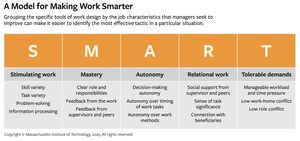CAMBRIDGE, Mass., March 3, 2021 /PRNewswire/ -- A new article released today by MIT Sloan Management Review reveals that companies with a digitally savvy top management team (TMT) perform better. Among larger companies, only a small fraction — 7% — had a TMT with more than half made up of digitally savvy members, and those companies outperformed the rest on growth and valuation by more than 48%.
Digital savviness is an understanding, developed through experience and education, of the impact that emerging technologies will have on a business's success over the next decade.
The article, titled "Does Your C-Suite Have Enough Digital Smarts?," reports that as the percentage of TMT members with digital savviness increases, so does net margin and revenue growth.
"As the global economy begins to recover from pandemic-induced slowdowns, the digital savviness of top teams will make the difference between the winners and the also-rans across industries and geographies," says Peter Weill, report coauthor, senior research scientist, and chair of the Center for Information Systems Research (CISR) at the MIT Sloan School of Management. "Now is the time to consider the digital savviness of your top management teams and ask yourself what you can do to bolster it for your company's future success."
The article is based on research that encompasses C-level executives and leaders of functions and geographic territories in 1,984 companies globally. (See "The Research" section of the article for research methodology details.)
Key study findings include:
1. The digital savviness of top executives varies widely by role and industry.
- Slightly fewer than 1 in 4 chief executive officers (CEOs), and only about 1 in 8 chief financial officers (CFOs), are digitally savvy. By contrast, 47% of chief technology officers (CTOs) and 45% of chief information officers (CIOs) are digitally savvy.
- The highest proportions of digital savvy executives — approximately one-third of top team members — work in media, software, and telecom. Only 12% of top team members are digitally savvy in the finance and insurance industry, underscoring its vulnerability to disruption by more agile fintech startups.
2. Digitally savvy top teams that combine strategic vision and financial skills deliver performance premiums.
- The few top teams in which half or more of members are digitally savvy have 45% higher revenue growth, 15% higher net margins, and 55% higher valuations than the rest of the companies studied.
- A digitally savvy CEO is associated with a 0.8 percentage point (pp) increase in revenue growth. Companies that partner such a CEO with a digitally savvy CFO, who can help identify which digital investments have potential to promote breakthrough performance, are able to produce an additional 5.9 pp increase in revenue growth, for a 6.67 pp increase in total.
3. Companies with digitally savvy top teams operate very differently in these three areas:
- Breakthrough performance via innovation, cross-selling, and business transformation. Leading companies in the top quartile generate 59% of revenue from innovations introduced within three years — compared with 18% of the bottom quartile companies.
- Enterprise practices create rapid learning cultures that are typified by test-and-learn experimentation, minimum viable product releases, and evidence-based decision-making. Companies in the top quartile have more than half of their core capabilities enabled by application programming interfaces (APIs) — compared with 19% of the bottom-quartile companies.
- Leadership uses a coach-and-communicate approach, not a command-and-control model. Rather than relying on instinct or what has worked in the past, digitally savvy top teams develop hypotheses and test them, looking for early measures of success that are correlated with financial performance. This allows executives to identify and solve problems sooner.
Read the MIT Sloan Management Review article, "Does Your C-Suite Have Enough Digital Smarts?" for practical and actionable recommendations that companies can take to increase the digital savviness of their senior executives.
MEDIA CONTACT:
Veronica Kido
[email protected]
508-242-5134
About the Authors
Peter Weill is a senior research scientist and chair of the Center for Information Systems Research (CISR) at the MIT Sloan School of Management. His work centers on the role, value, and governance of digitization in enterprises. Ziff Davis recognized Weill as No. 24 of The Top 100 Most Influential People in IT, the highest-ranked academic.
Stephanie Woerner is a research scientist at the MIT Sloan Center for Information Systems Research (CISR), where she studies how companies manage organizational change caused by the digitization of the economy. Her research centers on enterprise digitization and the associated governance and strategy implications.
Aman Shah is a doctoral candidate studying business information systems at Bentley University and a former senior research support specialist at the MIT Sloan Center for Information Systems Research (CISR).
About MIT Sloan Management Review
At MIT Sloan Management Review (MIT SMR) we explore how leadership and management are transforming in a disruptive world. We help thoughtful leaders capture the exciting opportunities--and face down the challenges--created as technological, societal, and environmental forces reshape how organizations operate, compete, and create value.
SOURCE MIT Sloan Management Review

Related Links
WANT YOUR COMPANY'S NEWS FEATURED ON PRNEWSWIRE.COM?
Newsrooms &
Influencers
Digital Media
Outlets
Journalists
Opted In






Share this article